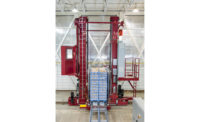Your Supply Chain is only as Safe as the Weakest Link

Do you know your suppliers’ suppliers? Do you have a food defense strategy in place? Are you challenged by cargo theft, fraudulent pickups and other not-so-safe  security measures?
security measures?
A supply chain is only as strong as its weakest link. And, for all food manufacturers, preparing a food defense strategy is more about knowing your supply chain’s vulnerabilities than simply just practicing food safety measures.
Marina Mayer, editor-in-chief of Refrigerated & Frozen Foods, talked exclusively with Don Hsieh, director of commercial and industrial marketing for Tyco Integrated Security, Boca Raton, Fla., at Tyco's sponsored event, Food Defense Strategy Exchange 2014, which took place April 29-May 1 in Chicago, to discuss the challenges refrigerated and frozen food processors face when practicing food safety and food defense and how a proper food defense strategy can help prevent intentional adulteration of food.
CLICK HERE to learn more about the live food crisis simulation and watch a video of how it worked.
Refrigerated & Frozen Foods: What do you see as being some of the most common challenges refrigerated and frozen food processors face when practicing food safety and food defense?
Don Hsieh: One of the interesting things coming out of this is the food defense issue really is very much about the whole supply chain. A lot of companies, especially the branded companies, have very good practices because they’re investing in their brand and have multiple layers of protection for food defense. But, the vulnerability in food defense is they use smaller suppliers, they use co-packers and they use smaller distributors. They use a lot of these entities, and truly the whole point is the adage “a chain is only as strong as the weakest link” is very relevant to food defense. A lot of what we heard [at the conference] today is the concern of understanding the cost impact that smaller suppliers face in terms of protecting against food defense, while keeping the focus on food defense on protecting against broad-scale contamination. However, if a small supplier is part of a chain that then gets distributed through a larger branded national product, the impact can still be broad. I think that’s probably one of the biggest challenges.
Refrigerated & Frozen Foods: What role does Tyco Integrated Security play in helping processors achieve and maintain their food safety and food defense goals?
Hsieh: We want to help them in all aspects of their food supply chain. In the sense of having multiple layers of security, we want to start from where the vulnerabilities are from even the first time something can be introduced to the product to the last. Starting with perimeter security, having multiple layers like the fencing, the lighting, all of that, to then inside the plant. A lot of people have good access controls and processes for employees, but when it comes to visitors and contractors and 3PLs, once they’re inside the plant, for the most part, they have access to almost anywhere in the plant. They’re supposed to be escorted in real practice, but often times, I’ve seen that it doesn’t always happen. So, what I think the FDA is pointing out is that there are vulnerabilities inside the plant that really have some key areas that need protection. They mentioned the mixing area, for example, which is inside the plant, usually in an open area. If someone puts in an ingredient contaminant, it can contaminate a large area. There are bulk storage facilities outside the plant, typically not very visible and not much monitoring. We can help protect that with video analytics of the perimeter, wireless cameras that can detect motion under low light, and those kinds of things can protect areas that are normally not being monitored on a regular basis. Inside the plant, besides the front door, we’re using advanced technologies that can detect when someone is not authorized to be in that area, even if there isn’t a door. It’s an open area, and you can kind of zone the area to say this is only where people with mixing authority can have access as a way to protect that area.
In the refrigerated food plants, there may be an issue with fraudulent pickups in terms of cargo theft. We provide identification management software that scans whether an ID is real or not. This can stop a John Doe who presents a counterfeit ID from taking away your cargo. It’s a proactive way to prevent adulteration that could arise from a deceptive pickup. For the cargo itself, we have partners that can track and detect whether or not the truck is on route or off route, and if it is being stolen, you can control and stop the truck, allowing you to prevent cargo theft rather than waiting until it didn’t get delivered before reacting.
Refrigerated & Frozen Foods: Based on the simulation today and coming from a security solutions provider, what were you looking for the attendees to achieve?
Hsieh: I think from the simulation itself, the biggest value is the need to really know your sources. Not only know your source one step down and one step up, but two steps or three steps away. What the simulation clearly showed was that you can significantly reduce both the economic impact and the timeframe of the impact if you can identify the source of the contamination more than one step down or up. I think that hopefully that’s a big take-away, because it does take a lot of work to know your supplier two hops away. Yes, we all know who our supplier is, but do we know who their supplier gets their products from? In this particular simulation, because you don’t know, most people sit and wait for clarity, and in that time, the amount of public health hazard and economic costs increases astronomically.
Refrigerated & Frozen Foods: What advice do you have for refrigerated and frozen food processors in terms of food defense?
Hsieh: One more key takeaway from a food defense perspective is it is clearly something the FDA is looking at that is no longer an optional thing. It’s a law because [food contamination] is really a big threat. Companies may be waiting to see what’s happening with the laws, but it would be prudent to be proactive and start looking and identifying all of your vulnerabilities and begin proactively working on it now because it does take time to implement a food defense strategy. It’s not something that launches and tomorrow you’re ready. It does take planning. Take some time to identify your vulnerabilities, plan on how to mitigate those risks and implement it. Be ready with a well thought-out food defense plan.
Looking for a reprint of this article?
From high-res PDFs to custom plaques, order your copy today!







